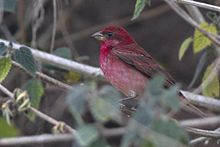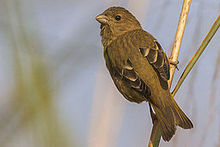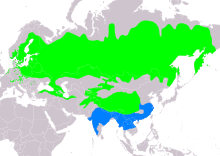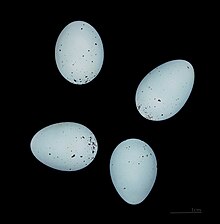
The true finches are small to medium-sized passerine birds in the family Fringillidae. Finches generally have stout conical bills adapted for eating seeds and nuts and often have colourful plumage. They occupy a great range of habitats where they are usually resident and do not migrate. They have a worldwide native distribution except for Australia and the polar regions. The family Fringillidae contains more than two hundred species divided into fifty genera. It includes the canaries, siskins, redpolls, serins, grosbeaks and euphonias, as well as the morphologically divergent Hawaiian honeycreepers.

The rosefinches are a genus, Carpodacus, of passerine birds in the finch family Fringillidae. Most are called "rosefinches" and as the word implies, have various shades of red in their plumage. The common rosefinch is frequently called the "rosefinch". The genus name is from the Ancient Greek terms karpos, "fruit", and dakno, "to bite".

The common redpoll or mealy redpoll is a species of bird in the finch family. It breeds somewhat further south than the Arctic redpoll, also in habitats with thickets or shrubs.

The twite is a small brown passerine bird in the finch family Fringillidae.

The purple finch is a bird in the finch family, Fringillidae. It breeds in the northern United States, southern Canada, and the west coast of North America.

The pine grosbeak is a large member of the true finch family, Fringillidae. It is the only species in the genus Pinicola. It is found in coniferous woods across Alaska, the western mountains of the United States, Canada, and in subarctic Fennoscandia and across the Palearctic to Siberia. The species is a frugivore, especially in winter, favoring small fruits, such as rowans. With fruit-crop abundance varying from year to year, pine grosbeak is one of many subarctic-resident bird species that exhibit irruptive behavior. In irruption years, individuals can move long distances in search of suitable food supplies, bringing them farther south and/or downslope than is typical of years with large fruit crops.

The scarlet myzomela or scarlet honeyeater is a small passerine bird of the honeyeater family Meliphagidae native to Australia. It was first described by English ornithologist John Latham in 1801. At 9 to 11 cm long, it is the smallest honeyeater in Australia. It has a short tail and relatively long down-curved bill. It is sexually dimorphic; the male is a striking bright red with black wings, while the female is entirely brown. The species is more vocal than most honeyeaters, and a variety of calls have been recorded, including a bell-like tinkling.
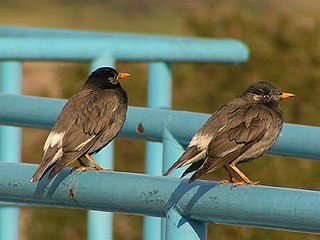
The white-cheeked starling or grey starling is a passerine bird of the starling family. It is native to eastern Asia where it is a common and well-known bird in much of its range.

The Cape siskin is a small passerine bird in the finch family. It is an endemic resident breeder in the southern Cape Province of South Africa.

The dark-breasted rosefinch is a species of true finch in the monotypic genus Procarduelis. It is found in Bhutan, China, India, Laos, Myanmar, Nepal, Pakistan, Thailand, and Vietnam. Its natural habitats are boreal forests and subtropical or tropical high-altitude shrubland.

The Tibetan rosefinch, also known as Roborovski's rosefinch, is a species of rosefinch in the finch family Fringillidae. It is sometimes placed in the monotypic genus Kozlowia. It is endemic to the Tibetan Plateau. Its natural habitat is montane tundra.

Blanford's rosefinch or the crimson rosefinch, is a species of finch in the family Fringillidae. It is found in Bhutan, China, India, and Nepal. Its natural habitat is boreal forest.

The scarlet finch is a small passerine bird in the finch family Fringillidae. It is found in the Himalayas from Uttarakhand state in the Indian Himalayas eastwards across Nepal, stretching further east to the adjacent hills of Northeast India and Southeast Asia as far south as Thailand. It is resident in the Himalayas, but many birds winter to the immediate south. Its natural habitat is temperate forests.

Sillem's rosefinch, also known as Sillem's mountain finch or tawny-headed mountain finch is a species of rosefinch in the finch family. It is found only in China and was only known from two specimens collected in 1929 from the Aksai Chin area of southern Xinjiang Autonomous Region. In 2012, the bird was photographed 1500 km from the original collection location. This species was originally placed in the genus Leucosticte but a phylogenetic study using mitochondrial DNA sequences published in 2016 found that Sillem's rosefinch was a sister species to the Tibetan rosefinch. The International Ornithological Committee therefore moved Sillem's mountain finch to the genus Carpodacus.

The crimson-browed finch is a true finch species. It is found in Bhutan, China, India, Myanmar, and Nepal. Its natural habitats are temperate forests and temperate shrubland.

The Siberian long-tailed rosefinch is a species of finch of the family Fringillidae.
Sharpe's rosefinch is a species of finch in the family Fringillidae. It is found in central China and far northern Myanmar. Its natural habitat is subtropical or tropical high-altitude shrubland. It was formerly considered to be a subspecies of the spot-winged rosefinch.
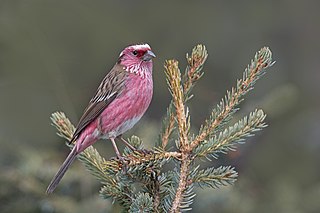
The Chinese white-browed rosefinch is a true finch species.
The Chinese beautiful rosefinch is a true finch species. It is one of the rosefinches that might belong in the genus Propasser. It is found in China and Mongolia. Its natural habitats are temperate shrubland and subtropical or tropical high-altitude shrubland.
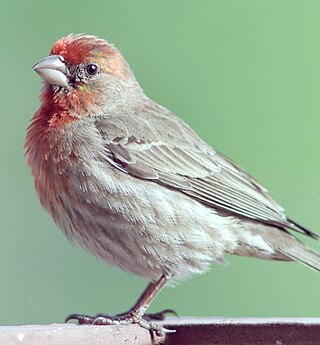
The American rosefinches that form the genus Haemorhous are a group of passerine birds in the finch family Fringillidae. As the name implies, various shades of red are characteristic plumage colors of this group. They are found throughout the North American continent.
